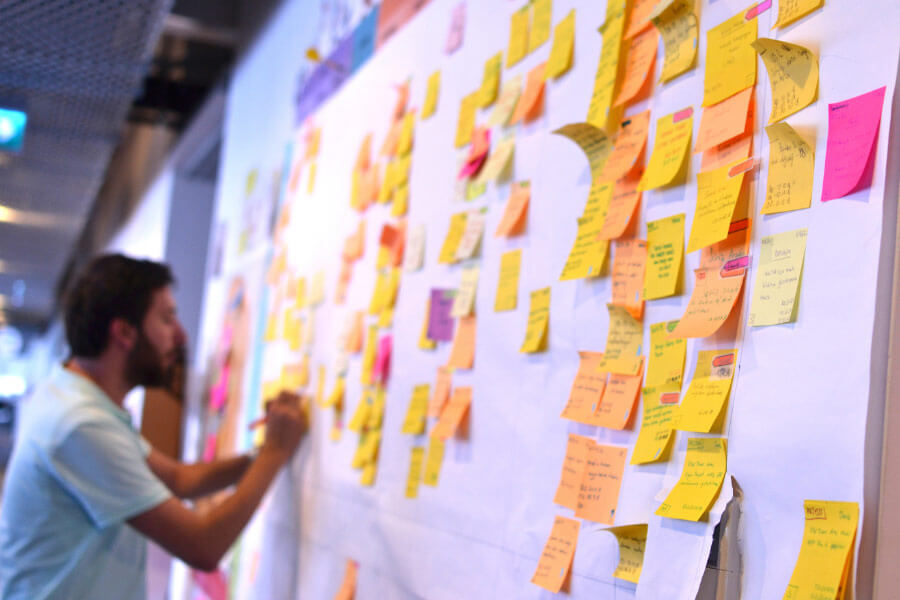From the origins to the practice, a short overview of agility, as we conceive it at Lucernys. An introduction to the Agile culture, at the heart of digital transformation.
Agile practices are becoming almost unavoidable for any company with the firm intention of transforming and modernizing itself in order to meet market expectations.
If it is indisputable that Agile and its various practices have been a fashion effect for several years, a preliminary question must be asked by any company or department manager who would like, in turn, to jump on the bandwagon towards new practices and make his employees benefit from them:
WHY WORK IN AGILE ?
Like any practice, the Agile culture (preferred to the commonly used – and debatable – name of “Agile method “) is introduced in companies to address various issues, which are summarized in four major points :
- Get rid of the myth of complete and fixed specifications – Respond to change and adapt your needs in the short term if necessary
- To be able to effectively manage complex projects, the ins and outs of which are not yet known, viaiterative and incremental practices
- Avoid integratingunnecessary features into products through a fast feedback loop
- Put the user at the center of your reflections and understand his need
The heart of this culture, of this state of mind (the famous ” Mindset Agile “) is very well summarized in the original Agile Manifesto, written in 2001 by a group of 17 business leaders or managers from different countries.
You can find the four values and the twelve principles of Agile by following the link : http://agilemanifesto.org/
Originally written to address issues related to software development, it has now been extended to a broader set of issues: solutions(http://manifesteagile.fr/index.html). Agile does not stop only at IT developments, and can be adapted to marketing or to anything that could be concerned by the four points mentioned above.
Note: if Agile can be applied in many areas today, it is not compatible with everything, hence the importance of understanding the problems you want to solve.
The Agile Mindset can be visually represented as follows :

It is essential to understand what this mindset is before implementing Agile frameworks.
Depending on your needs, you can adopt Agile and its practices for a small team of ten people, for a department or even better, for your entire organization.
Different Agile frameworks and practices have been designed and developed over the years and the experiences of your peers and predecessors to meet their expectations.
Scrum (https://www.scrum.org/) and SAFe (https://www.scaledagileframework.com/) are two of the best known and most used frameworks today, but they are neither exclusive nor exhaustive.
THE SCRUM FRAMEWORK
Although its contours were first defined in 1995, the Scrum Guide was written in 2011 and then adapted as practices evolved. Its latest version dates from the end of 2020. It is available at this address: https://www.scrumguides.org/scrum-guide.html
 It is based on 3 pillars and 5 values …
It is based on 3 pillars and 5 values …
The 3 pillars
– The transparency: key success factor, transparency is at the heart of the approach: giving access to information based on a common language and definitions. The team must have a clear and shared vision to collectively validate the steps.
–Inspection: theteam must constantly consult each other to detect any discrepancies between the iteration’s objective and the work done(daily scrum, sprint review, sprint retrospective).
–Adjustment: if deviations are found, an adjustment must be undertaken.
The 5 values
Although they were not invented by Scrum, these values are there to give meaning and direction to our work, our behavior and our actions. All Scrum-related practices and choices should reinforce these notions, not undermine them.
– Courage : the Scrum team members have the courage to assume their choices – to know how to say no – and to stay the course with mutual support despite the pitfalls.
– Commitment : this value is about team members’ dedication to the project. Everyone is dedicated to their work and to the effort they will have to put in. A misinterpretation would be to believe that this is a commitment to results.
– Focus : everyone must focus on the work of the sprint in progress during the iteration and be impervious to other solicitations.
– Openness : Scrum’s empiricism requires transparency. We wish to inspect the work done in order to continuously improve it. To do this, you need to be open about your work, the progress you are making, the learning from others and the challenges that every project faces.
– Respect : the Scrum team respects each contributor. This implies taking collective responsibility for both successes and failures.
You can find a more in-depth and complete explanation of Scrum’s values at the following address (article in English): https://guntherverheyen.com/2013/05/03/theres-value-in-the-scrum-values/
The Scrum Cycle
It is repeated every 2 to 4 weeks, at each sprint
Scrum is a simple framework, compatible with a team of ten people or less, which can easily be set up. It can be summarized as follows :
– 3 roles : scrum master, product owner, developer
– 5 ceremonies (or events): sprint, sprint planning, daily scrums, sprint review and retrospective
– 3 artifacts associated with 3 commitments (or deliverables):
-
- the product backlog > Commitment: The product goal
- the sprint backlog > Commitment: The Sprint Goal
- the increment > Commitment: Definition of Done
For more details on the framework and its concepts, feel free to consult the latest Scrum Guide linked above.
It is an ideal framework if you want to start in Agile without initiating a large-scale transformation.
The cycle can be represented as follows:

THE SCALED AGILE FRAMEWORK
SAFe is now one of the most widely used frameworks worldwide for enterprise-wide agility practices. As soon as a project involves several dozen people, and they have to synchronize to deliver solutions that depend on each other, all at a regular pace… it’s a framework to consider.
[vc_single_image image= “5522″ img_size= ” ” style= “vc_box_border ” onclick= “link_image ” css_animation= “fadeIn “] It was designed to match a speed of innovation and delivery with the stability provided by a functional hierarchy, as it exists today in most contexts.Thanks to the SAFe implementation roadmap, you will have all the data at your disposal to train your management, business and operational teams. You will be able to implement your first teams: the Agile release trains based on key value chains identified beforehand.
Beyond strategic coaching, LUCERNYS is involved with you in its implementation on a daily basis, through its teams of consultants, trainers and Agile coaches, to make this metamorphosis a success!







